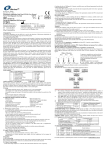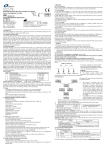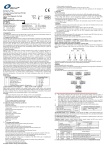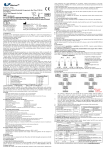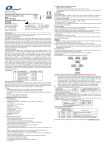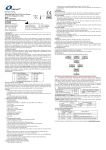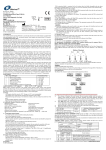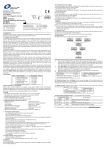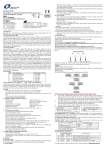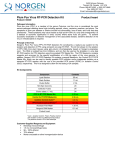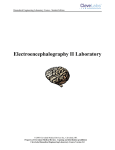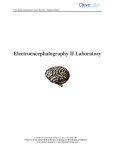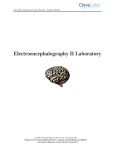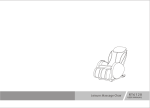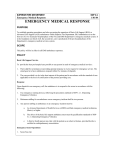Transcript
Revision No.: ZJ0001 Issue Date: Jul 1st, 2012 Human Herpes Virus(HHV-6) Real Time PCR Kit User Manual For In Vitro Diagnostic Use Only OD-0169-01 For use with LightCycler1.0/2.0 Instrument Obelis S.A. Boulevard Général Wahis 53 1030 Brussels, BELGIUM Tel: +(32) 2.732.59.54 Fax: +(32) 2.732.60.03 E-Mail : [email protected] Shanghai ZJ Bio-Tech Co., Ltd. www.liferiver.com.cn Tel: +86-21-34680596 [email protected] Fax: +86-21-34680595 nd 2 floor,No.15 Building,No.188 Xinjunhuan Road, PuJiang Hi-tech Park, Shanghai, China 1. Intended Use Human Herpes Viurs real time PCR kit is used for the detection of Human Herpes Viurs in serum, plasma,C.S.F or herpes secretion by using real time PCR systems. 2. Principle of Real-Time PCR The principle of the real-time detection is based on the fluorogenic 5’nuclease assay. During the PCR reaction, the DNA polymerase cleaves the probe at the 5’ end and separates the reporter dye from the quencher dye only when the probe hybridizes to the target DNA. This cleavage results in the fluorescent signal generated by the cleaved reporter dye, which is monitored real-time by the PCR detection system. The PCR cycle at which an increase in the fluorescence signal is detected initially (Ct) is proportional to the amount of the specific PCR product. Monitoring the fluorescence intensities during Real Time allows the detection of the accumulating product without having to re-open the reaction tube after the amplification. 3. Product Description HHV-6 was discovered in 1986 in AIDS patients with cancer and lymphoproliferative disorders.HHV-6 is an immunosuppressive and neurotropic virus that can cause encephalitis and seizures during a primary infection or when reactivated from latency in immunosuppressed patients. HHV-6 may play a role in several chronic neurological conditions including MS, mesial temporal lobe epilepsy, status epilepticus and chronic fatigue syndrome. There are two distinct variants of HHV-6. HHV-6A is the strain most likely to be found in MS, CFS and AIDS and cancer patients. HHV-6B causes roseola, febrile illnesses and encephalitis in infants and reactivates in transplant patients, causing complications such as encephalitis, pneumonitis and liver failure. HHV-6 real time PCR kit contains a specific ready-to-use system for the detection of HHV-6 by polymerase chain reaction (PCR) in the real-time PCR system. The master contains reagents and enzymes for the specific amplification of HHV-6 DNA. Fluorescence is emitted and measured by the real time systems´ optical unit during PCR. The detection of amplified HHV-6 DNA fragment is performed in fluorimeter channel 530nm with the fluorescent quencher BHQ1. DNA extraction buffer is available in the kit. In addition, the kit contains a system to identify possible PCR inhibition by measuring the 560nm fluorescence of the internal control (IC). An external positive control (1×107copies/ml) allows the determination of the gene load. For further information, please refer to section 9.3 Quantitation. 4. Kit Contents Ref. Type of Reagent Presentation 25rxns 1 DNA Extraction Buffer 1 vial, 1.8ml 2 HHV-6 Reaction Mix 1 vial, 450µl 3 PCR Enzyme Mix 1 vial, 12µl 4 Molecular Grade Water 1 vial, 400µl 5 Internal Control (IC) 1 vial, 30µl 7 6 HHV-6 Positive Control (1×10 copies/ml) 1 vial, 30µl 3 3 Analysis sensitivity: 1×10 copies/ml; LOQ: 2×10 ~1×108 copies/ml Note: Analysis sensitivity depends on the sample volume, elution volume, nucleic acid extraction methods and other factors .If you use the DNA extraction buffer in the kit, the analysis sensitivity is the same as it declares. However, when the sample volume is dozens or even hundreds of times greater than elution volume by some concentrating method, it can be much higher. 5. Storage • All reagents should be stored at -20°C. Storage at +4°C is not recommended. • All reagents can be used until the expiration date indicated on the kit label. • Repeated thawing and freezing (>3x) should be avoided, as this may reduce the sensitivity of the assay. • Cool all reagents during the working steps. • Reaction Mix should be stored in the dark. 6. Additionally Required Materials and Devices • Biological cabinet • Real time PCR system • Trypsin digestive Solution • Vortex mixer • Real time PCR reaction tubes/plates • Cryo-container • Pipets (0.5 µl – 1000 µl) • Sterile filter tips for micro pipets • Sterile microtubes • Disposable gloves, powderless • Biohazard waste container • Refrigerator and Freezer • Tube racks • Desktop microcentrifuge for “eppendorf” type tubes (RCF max. 16,000 x g) 7. Warnings and Precaution Carefully read this instruction before starting the procedure. • For in vitro diagnostic use only. • This assay needs to be carried out by skilled personnel. • Clinical samples should be regarded as potentially infectious materials and should be prepared in a laminar flow hood. • This assay needs to be run according to Good Laboratory Practice. • Do not use the kit after its expiration date. • Avoid repeated thawing and freezing of the reagents, this may reduce the sensitivity of the test. • Once the reagents have been thawed, vortex and centrifuge briefly the tubes before use. • Prepare quickly the Reaction mix on ice or in the cooling block. • Set up two separate working areas: 1) Isolation of the RNA/ DNA and 2) Amplification/ detection of amplification products. • Pipets, vials and other working materials should not circulate among working units. • Use always sterile pipette tips with filters. • Wear separate coats and gloves in each area. • Do not pipette by mouth. Do not eat, drink, smoke in laboratory. • Avoid aerosols 8. Sample Collection, Storage and transport • Collect samples in sterile tubes; • Specimens can be extracted immediately or frozen at -20°C to -80°C. • Transportation of clinical specimens must comply with local regulations for the transport of etiologic agents 9. Procedure 9.1 DNA-Extraction DNA extraction buffer is supplied in the kit, please thaw the buffer thoroughly and spin down briefly in the centrifuge before use. It’s better to use commercial kits for nucleic acid extraction. 9.1.1 Blood sample 1) Pipet 50µl serum or plasma (non-heparin anticoagulation) to a new 0.5ml tube, add 50µl DNA extraction buffer, close the tube then vortex for 10 seconds. Spin down briefly in a table centrifuge. 2) Incubate the tube for 10 minutes at 100°C. 3) Centrifuge the tube at 13000rpm for 10 minutes. The supernatant contains the DNA extracted and can be used for PCR template. 9.1.2 Herpes secretion sample 1) Add 0.5ml normal saline to the herpes secretion sample, and vortex vigorously. 2) Transfer 50µl liquid into another tube, add 50µl DNA extraction buffer, close the tube then vortex for 10 seconds. Spin down briefly in a table centrifuge. 3) Incubate the tube for 10 minutes at 100°C. 4) Centrifuge the tube at 13000rpm for 10 minutes. The supernatant contains the DNA extracted and can be used for PCR template. 9.1.3 C.S.F sample 1) Take 1ml sample in a tube, centrifuge the tube at 13000rpm for 2min, and remove the supernatant and keep the pellet. 2) Add 100µl DNA extraction buffer to the pellet, close the tube then vortex for 10 seconds. Spin down briefly in a table centrifuge. 3) Incubate the tube for 10 minutes at 100°C. 4) Centrifuge the tube at 13000rpm for 10 minutes. The supernatant contains the DNA extracted and can be used for PCR template. Attention: A. During the incubation, make sure the tube is not open. Since the vapor will volatilize into the air and may cause contamination if the sample is positive. B. The extraction sample should be used in 3 hours or stored at -20°C for one month. C. DNA extraction kits are available from various manufacturers. You may use your own extraction systems or the commercial kit based on the yield. For the DNA extraction, please comply with the manufacturer’s instructions. 9.2 Internal Control It is necessary to add internal control (IC) in the reaction mix. Internal Control (IC) allows the user to determine and control the possibility of PCR inhibition. Add the internal control (IC) 1µl/rxn and the result will be shown in the 560nm 9.3 Quantitation The kit can be used for quantitative or qualitative real-time PCR. A positive control (1×107copies/ml) is supplied in the kit. For performance of quantitative real-time PCR, Standard dilutions must prepare first as follows. Molecular Grade Water is used for dilution. Dilution is not needed for performance of qualitative real-time PCR. Take positive control (1×107copies/ml) as the starting high standard in the first tube. Respectively pipette 36ul of Molecular Grade Water into next three tubes. Do three dilutions as the following figures: To generate a standard curve on the real-time system, all four dilution standards should be used and defined as standard with specification of the corresponding concentrations. Attention: A. Mix thoroughly before next transfer. B. The positive control contains high concentration of the target DNA. Therefore, be careful during the dilution in order to avoid contamination. 9.4 PCR Protocol The Master Mix volume for each reaction should be pipetted as follows: ※PCR system without 560nm channel may be treated with 1µl Molecular Grade Water instead of 1µl IC. 1) The volumes of Reaction Mix and Enzyme Mix per reaction multiply with the number of samples, which includes the number of the controls,standards and sample prepared. Molecular Grade Water is used as the negative control. For reasons of unprecise pipetting, always add an extra virtual sample. Mix the master mix completely then spin down briefly in a centrifuge. 2) Pipet 18µl Master Mix with micropipets of sterile filter tips to each Real time PCR reaction plate/tube. Then separately add 2µl DNA sample, positive and negative controls to different reaction plate/tubes. Immediately close the plate/tubes to avoid contamination. 3) Spin down briefly in order to collect the Master Mix in the bottom of the reaction tubes. 4) Perform the following protocol in the instrument: 37°C for 2min 1cycle Selection of fluorescence channels 94°C for 2min 1cycle 530nm Target Nucleic Acid 93°C for 5sec, 60°C for 30sec 560nm IC 40cycles ( Fluorescence measured at 60°C) 10.Threshold setting: Choose Arithmetic as back ground and none as Noise Band method, then adjust the Noise band just above the maximum level of molecular grade water, and adjust the threshold just under the minimum of the positive control. 11.Calibration for quantitative detection: Input each concentration of standard controls at the end of run, and a standard curve will be automatically formed. 12.Quality control: Negative control, positive control, internal control and QS curve must be performed correctly, otherwise the sample results is invalid. Channel Crossing point value Control 530nm 560nm Molecular Grade Water Blank 25~35 Positive Control(qualitative assay) ≤35 —— QS(quantitative detection) Correlation coefficient of QS curve≤-0.98 13. Data Analysis and Interpretation The following results are possible: Crossing point value Result Analysis 530nm 560nm 1# Blank 25~35 Below the detection limit or negative 2# Positive; and the software displays the quantitative value ≤35 —— 3# 25~35 Re-test; If it is still 35~40, report as 1# 35~40 4# Blank Blank PCR Inhibition; No diagnosis can be concluded. For further questions or problems,please contact our technical support at [email protected]
